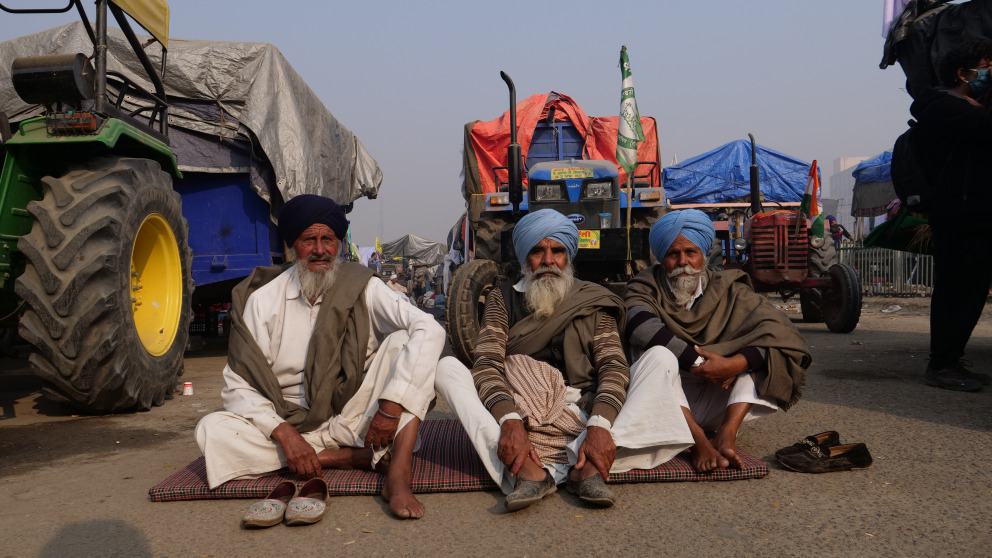“Struggle for Agrarian and Environmental Justice: The Farmers Movement in Northwest India”
04.04.2022

By Navdeep Boora (Indian Institute of Science Education & Research) and Bernardo Jurema (IASS)
The struggle for agrarian and environmental justice by the farmers movement in Northwest India was the second lecture in this year’s IASS Focal Topic series “Justice in Sustainability.” Our guest, Navdeep Boora, is a graduate student at the Indian Institute of Science Education & Research (IISER) Mohali. In his presentation, Navdeep gave us insights into the farmers’ protest against the Indian government’s attempt to further liberalize the country’s agricultural sector in 2021. While India’s farmers’ protests are a rare success story of grassroots mobilization against the powerful in India, they also touch on important aspects of justice in sustainability such as food production, food security, and land rights.
Here are some of the insights Navdeep presented:
Agriculture in India
Despite the diversification of the Indian economy, agriculture, with its associated sectors, remains one of the largest sources of livelihood in India, accounting for 70 percent of the country’s rural households. Most farmers are small-scale, with land ownership of one to two hectares. The majority grow cereal crops such as wheat and rice. Agriculture’s contribution to GDP has steadily declined from 54 percent in 1951 to 20.2 percent in 2020-2021. While India’s grain production is increasing every year, it is doing so at a slower pace than other large producing countries such as China, Brazil, and the USA. Agricultural productivity depends on several factors, such as availability and quality of agricultural inputs like land, water, seeds and fertilizers, access to agricultural credit and crop insurance, and the assurance of remunerative prices for agricultural produce, storage, and marketing infrastructure.
Ecological calamity at the root of Indian farmers’ protests
Despite low yields, agriculture production in India is resource-intensive, and this has raised serious sustainability issues. These include increasing stress on water resources, desertification, and land degradation. Punjab, the focus point of the farmers’ movement in India, is facing an ecological disaster due to the overuse of pesticides and chemical fertilizers in the soil since the Green Revolution of the late 1960s. At the time, Punjab had 21 crops in its cropping system; currently, there are only nine, and all of them require a huge amount of inland water for irrigation. Rice has replaced many of Punjab’s native crops, and this process is still underway. Every year more and more farmers are shifting towards rice as it assures them income through the MSP (Minimum Support Price, a minimum price guarantee that acts as a sort of insurance for farmers when they sell certain crops). This has led to increased stubble burning and worsening air quality in North India.
Liberalization of the agriculture sector triggers farmers’ protests
At the heart of the protest is the government’s desire to open India’s agricultural market. The widespread protests were a result of three farm bills passed by the central government to introduce new agriculture policy, especially in the Green Revolution belt of North India, often referred to as the country’s breadbasket. The government presents these policies as historic reforms which promise freedom to the farmers from Agriculture Produce Market Committees (APMCs) and the middleman who charges a commission for trade in the cooperative markets’ yards, locally known as APMC mandi. However, farmers argue that these acts do not give the freedom to them but to private capitalists, and say that the government has introduced these reforms to benefit corporations, not farmers.
For many years farmers were protesting and demanding reforms in the functioning of APMCs, but this time farmers are fighting for restoring the primacy of the Mandis in the agricultural trade because they are an essential part of their agricultural trading ecosystem. Farmers make assured income through the procurement of wheat and rice on Minimum Support Price by APMCs and have faith in the Mandi system with the assurance of MSP and timely payments. Given the diversity of the legal frameworks in governing the agrarian lands, and restrictions on the corporations for buying or leasing the agricultural land made it difficult for the latter to enter the agricultural economy. With the eagerness for private investment in agriculture, the government did the required groundwork that would easily enable the expansion of corporations in India’s agriculture sector. The entry of corporations would further intensify agriculture which will enhance farmers’ exploitation and the environmental crisis.
Indian government backtracked in the face of farmers’ yearlong protest
The farmers demanded the repeal of the new farm laws as well as guaranteed procurement based on the MSP as a legal right for every farmer. They protested for months in their respective states, facing all sorts of hardships for more than one year. For this reason, the movement is said to be the longest agrarian struggle in India’s history. The farmers’ protest received an outpouring of support from the Indian diaspora and solidarity from all over the globe, including well-known personalities like Rihanna and Greta Thunberg. After protesting for 378 days at Delhi’s borders, the central government finally accepted all the farmers’ major demands.
The diversification of crops is not happening on the ground due to income concerns, so it needs major rethinking. This issue must be addressed by a movement from below. Any policy to do so needs to be viable as we have a population of 1.3 billion to feed.
About the presenter
Navdeep is currently studying the contemporary peasant movement against the three farm laws introduced by the Indian government. Navdeep was also an active participant in the farmers’ protests against the farm laws.
Media
Navdeep Boora: Agrarian and Environmental Justice - The Farmers Movement in Northwest India

